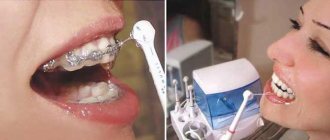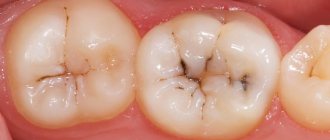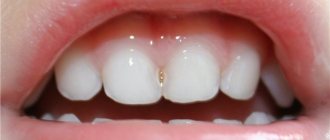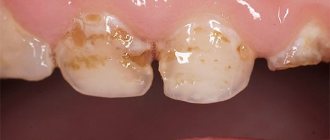Mechanism of caries development
Caries is a dental pathology that destroys the structure of the tooth. It develops when a large number of cariogenic bacteria create a lot of organic acid in the mouth. It penetrates the structure of enamel and dentin, softens them, which leads to carious lesions. The more bacteria and the acid they produce, the more active dental caries develops.
In this article
- Mechanism of caries development
- Why is it important to stop tooth decay?
- Can dental caries be prevented?
- Fissure sealing is a way to prevent or slow down caries in a child
- How to stop caries?
- How can you stop caries at the spot stage?
- Features of caries in elderly patients: how to slow it down
- Conclusion
This pathology affects people of different ages. In recent years, experts have noted a trend towards an increase in morbidity among children. According to statistics, by the age of seven, approximately 85% of children’s teeth are affected by caries, and among the adult population this dental disease ranks first in prevalence.
Tinctures and decoctions
When wondering how to treat dental caries at home, you can choose an excellent alternative method - make a tincture or decoction.
There are many options, and preparation will not cause much trouble:
| Recipe name | Components | Cooking instructions |
| Sage decoction |
| Add sage to boiling water and let the broth brew for 1 hour. Next, you can rinse your mouth with the resulting product or apply a cotton wool soaked in the broth to the sore tooth. |
| Onion peel infusion |
| Mix the ingredients and put on the stove. Bring to a boil, leave on low heat for another 5-10 minutes, then let it brew for 8 hours and strain. Rinse with infusion several times a day, it perfectly relieves pain and disinfects the oral cavity. |
| Calamus tincture |
| Mix calamus with vodka and let it brew for one week. Rinse your mouth diluted with water every day, preferably before going to bed. |
| Herbal collection | Take in equal proportions:
| Mix all ingredients and pour boiling water. Let it sit for a while and irrigate the mouth 3 times a day. |
| Chinese lemongrass tea |
| Brew and steep the tea in a water bath for about half an hour. When drinking the drink, you should hold the liquid in your mouth for a few seconds. The prepared decoction has an antibacterial and immunomodulatory effect, and its regular use prevents the risk of developing caries in the early stages |
| Raspberry-mint infusion |
| Brew mint and raspberry leaves with boiling water and let stand in a water bath for about half an hour. Next, strain, add wine vinegar to the solution and let it brew for several days. Afterwards, rinse your mouth with the prepared tincture every day. |
| Decoction with propolis, strawberries and nettles |
| Mix all ingredients and place the container in a warm place. Then strain and irrigate mucous membranes after each meal. |
You can learn more about traditional methods of treating caries in the initial stages from the video in this article.
Tinctures and decoctions for rinsing
Why is it important to stop tooth decay?
Any disease is easier to prevent than to treat. And dental caries is no exception. There are many reasons why it is important to stop the progression of tooth decay as early as possible.
- It is easier to treat teeth at an early stage.
The peculiarity of caries is that it develops gradually and relatively slowly. At an early stage, it looks like a small chalky stain on the enamel and is very easy to treat. The damaged area of the tooth is covered with special gels and solutions that restore the mineral composition of the enamel, or treated with an infiltration composition - it seals the enamel pores. The main thing is that caries can be treated at an early stage without preparing the carious cavity. It is quick, painless, simple and allows you to preserve the integrity of the tooth.
- Treatment in later stages is painful.
If the further spread of caries is not stopped, it will penetrate into the deeper tissues of the tooth, which will lead to the formation of a cavity and sometimes damage to the pulp. Such caries is treated with drilling, cleaning, filling - such procedures are unpleasant and painful, and therefore require anesthesia.
- With untreated caries, there is a risk of severe destruction or complete loss of the tooth.
In such cases, crowns or implants will have to be installed, which involves large financial costs. In addition, an artificial tooth does not have the same strength as a real one, and its useful life is limited.
- Carious teeth are a source of infection.
Teeth affected by caries are a source of chronic infection in the body. The deeper the process spreads, the greater the risk of infection of other organs and tissues.
- Bad teeth lead to digestive problems.
Teeth support the chewing process. With caries, they become less durable, cease to cope well with the chewing function, which is fraught with digestive disorders and can lead to gastrointestinal diseases.
- Aesthetics are compromised.
Teeth are not only health, but also beauty. Teeth affected by caries darken, holes form in them, the smile loses its attractiveness, which is reflected in a person’s appearance.
- Complex caries is more expensive to treat.
Dental treatment is not cheap. Moreover, the more serious the problem, the more expensive it will cost. Therefore, stopping caries at an early stage is much more profitable from a financial point of view.
Can dental caries be prevented?
The fact that about 90% of the world's inhabitants have caries does not mean that this pathology cannot be prevented. An integrated approach to preventive measures will significantly reduce the risk of dental caries.
- Regular teeth cleaning.
Oral hygiene comes first in importance in the development of caries. Cariogenic bacteria live in dental plaque and feed on food debris. If you brush your teeth, as doctors recommend, twice a day for at least 2-3 minutes, following the basic rules of brushing, you can protect your teeth from caries.
- Use of additional hygiene products.
Using dental floss and irrigator, along with a brush and paste, helps improve the quality of oral care and reduce the risk of dental caries. The floss is needed to clear the interdental spaces of partially stuck food. This helps prevent contact caries developing on the lateral surfaces of the teeth. Using a powerful water jet, the irrigator cleans not only the interdental spaces, but also periodontal pockets, the space under crowns, dentures and other hard-to-reach areas.
- Strengthening the immune system.
A weakened immune system cannot resist the destructive effects of bacteria. Therefore, in order to prevent the development of dental caries, it is important to strengthen the immune system. An integrated approach may include hardening, proper nutrition, a healthy lifestyle, and taking vitamin supplements as prescribed by a doctor.
- A balanced diet rich in vitamins and microelements.
To prevent or slow down the development of caries, it is necessary to adjust nutrition in several areas. Reduce your consumption of simple carbohydrates - sugary foods and drinks, baked goods, fast food. Reduce the number of snacks and stop eating sweets at night. Make sure your diet includes plenty of foods rich in phosphorus, calcium, fluoride, and vitamin D. There should also be plenty of solid vegetables and fruits, which naturally cleanse your teeth of food debris and plaque.
Tricks for fighting caries at home
Answers to questions - how to defeat caries, how to kill pathogenic bacteria or how to stop their destructive and destructive effects - are of keen interest to many people. To reduce the likelihood of your visit to the dentist not for prevention, but for treatment, it is advisable to consider some tricks that help fight the initial stage of the disease:
- Solid foods, such as fruits and vegetables, help maintain healthy teeth by ridding them of some microorganisms.
- Chewing gum helps fight caries; here you can really believe the advertising, but you should remember that we are talking only about those chewing gums that do not contain sugar.
- An excellent preventive measure is dental floss. It makes it possible to brush teeth in places that are not easily accessible by other means. If you want to know how to clean them, use floss.
- Meals should be completed by brushing your teeth; there is no more effective way to monitor oral health.
Fissure sealing is a way to prevent or slow down caries in a child
Caries in a child can be stopped by fissure sealing. Fissures are the natural grooves and grooves on the chewing surface of the teeth. The anatomical features of their structure are such that food debris is easily retained in the fissures, and the process of enamel mineralization is slower than in other areas of the teeth.
To prevent dental caries (most often in children, but the method is also applicable for adults), fissures are sealed. The essence of the method is that natural grooves are covered with special dental sealants containing calcium and fluoride. Sealants seal the tooth, preventing the impact of cariogenic factors on it, and the mineral components included in the composition nourish the dental tissues.
The main indication for sealing is deep fissures that are difficult to clean during daily oral hygiene.
It is optimal for a child to seal the grooves on the teeth six months after teething. At about 6-8 years old, the child’s permanent teeth begin to be sealed - first the first molars, closer to 10 years - the premolars, and by the age of 12-13 - the second molars.
Sealing is not carried out if caries has already formed in the fissures - like a stain or a cavity in the tooth.
The sealing procedure can be invasive or non-invasive; the technology is selected by the doctor individually for each patient. If the fissure is clearly visible, it is sealed using a non-invasive method: the tooth is cleaned of plaque, treated with a special gel that ensures reliable fixation of the filling, sealant is applied and illuminated with a lamp. For narrow and deep fissures, the bottom and walls of which are difficult to see to ensure the absence of caries, the dentist chooses an invasive sealing method.
After cleaning the tooth, the fissures are opened with a drill and their condition is assessed. In the absence of carious lesions, further sealing is carried out similarly to the non-invasive method. Fissure sealing is one of the most effective ways to prevent caries in chewing teeth.
How effective is the treatment of caries using traditional methods?
Medicines recommended by traditional medicine disinfect the oral cavity - this is a fact, but microorganisms do not disappear anywhere, they only develop a little more slowly. According to reviews, treating caries at home muffles the pain, reduces tooth sensitivity, but does not solve the problem. Only a dentist can stop the destructive process! Folk remedies help in the prevention of oral diseases, but if a hole has already appeared in the tooth, they are powerless. This is the case when it is better to trust the dentists and not conduct checks on your own experience.
How can you stop caries at the spot stage?
The first stage, in which only a small light spot forms on the enamel, is the most favorable from the point of view of treatment prognosis. At an early stage of caries, it is possible to cure it without painkilling injections, preparation of the carious cavity, or filling.
How to stop caries is decided by the dentist in each specific case, but today there are several possible non-invasive methods.
- Remineralization of enamel.
Caries begins when tooth enamel loses minerals, loses its strength and cannot effectively protect the deep tissues of the tooth from the acid produced by bacteria. Remineralizing therapy is aimed at restoring the balanced composition of the enamel, strengthening its structure, and returning its strength and protective characteristics. The essence of the method is that the dentist alternately applies compositions containing phosphorus, calcium and other useful substances to the cleaned tooth surface. Another way is to attach special trays with remineralizing gel to the teeth.
- Fluoridation.
Using this method, you can increase the strength of enamel, its resistance to acid, eliminate microdamage, and reduce the pain reaction to cold/hot. Saturation of dental tissues with fluoride ions helps to achieve this effect. A simple or deep fluoridation procedure is possible. In the first case, the dentist uses fluoride varnishes or fluoride gels. They are applied to the teeth using trays or cover the surface of the enamel with a brush. In deep fluoridation, compounds are used to seal tooth enamel. The teeth are first cleaned, dried, isolated from saliva, deep fluoride is applied to them, dried again, and then treated with copper-calcium hydroxide. With this method, a fluoride-containing substance penetrates deeply into the pores of tooth enamel and helps preserve calcium.
- Infiltration method.
Another method will stop the development of caries at the spot stage without drilling and filling, and will prevent the formation of a carious cavity. First, the dentist treats the carious stain with a special etching composition; the next step is to apply a liquid composition to the cleaned, washed and dried surface to seal the pores of the tooth. The infiltration method helps stop the spread of the carious process, since the acid produced by bacteria cannot penetrate the sealed pores of the enamel and continue the destructive process. The method is completely safe, painless and suitable even for children over three years old. This treatment is usually not performed on a younger child, because during the procedure you need to sit still for about 20 minutes, which is not possible for small children.
In addition to the listed methods, ozone therapy and laser therapy are used today, which also help stop the carious process without tooth preparation. If a hole has already formed, then the only way to stop caries is surgical treatment. Using a drill, the doctor removes the affected tissue, prepares the cavity for filling and installs the filling there layer by layer, returning the tooth to its natural anatomical shape.
Application of enzyme gel –
Instead of a drill, special enzyme gels can be used to remove caries, which dissolve only the tissues affected by caries, without touching the healthy hard tissues of the tooth. This is an excellent tool for use especially in children's practice. There are a large number of manufacturers of such products, and one of the options is BRIX 3000 enzyme gel, the principle of operation of which you can see in the videos below.
The enzyme gel is introduced into the carious cavity for about 2 minutes, after which the softened carious tissues are scraped out of the carious cavity using a special tool. After this, the cavity is washed out and filling of the tooth can begin. True, in some cases it may be necessary to use a drill to smooth out the edges of the tooth enamel hanging over the carious cavity.
Application of enzyme gel –
Features of caries in elderly patients: how to slow it down
Elderly people are considered to be over 60 years of age. Caries in the elderly develops under the influence of the same cariogenic factors as in younger people, but there are some peculiarities.
A study conducted in a Swiss clinic showed that in patients aged 50-94 years, a quarter of the remaining teeth were affected by caries.
One of the characteristic features of caries in the elderly is its localization in the neck of the tooth. Often in older people, carious lesions do not spread deep into, but along the surface of the tooth enamel. Many people wear dentures, and the teeth in contact with them are often affected by caries. A large percentage of defects are recurrent and chronic caries.
As you age, the risk of tooth root caries increases, which some doctors call the main problem in treating the teeth of older people.
Effective measures to prevent caries in the elderly are:
- professional oral hygiene twice a year;
- brushing your teeth twice a day using a toothbrush, toothpaste and floss;
- use of saliva thinners;
- deep fluoridation of dental tissues.
This set of preventive measures helps reduce the risk of developing caries in the elderly by more than half.









